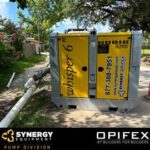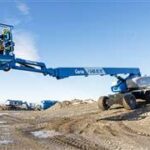So you need a boom lift.
You’ve got a job to do—something up high, out far, or awkwardly around a rooftop corner.
You’ve narrowed it down to the right model… and then it hits you:
“Should I buy this thing? Rent it? Or just cry into the budget sheet?”
Let’s break it down—cost, value, and the best way to go vertical without going broke.
💸 First Up: What Does a Boom Lift Actually Cost?
Boom lifts aren’t bicycles. They’re precision-engineered aerial beasts—and the price tag reflects that.
🔹 Buying a Boom Lift
Here’s the rough cost range based on size and type:
| Type | New Price Range |
|---|---|
| Articulating boom (30–60 ft) | $30,000 – $85,000 |
| Telescopic boom (60–120 ft) | $60,000 – $180,000 |
| Hybrid/electric models | Add $5K–$10K premium |
Used units? You can knock off 20%–50%, depending on age and hours.
Example:
-
New Genie Z-45/25J: ~$65,000
-
Used version (3–5 yrs, <2,000 hrs): ~$35,000–$45,000
🔄 Renting: The Pay-As-You-Lift Option
If your job is short-term, or you just need the lift once or twice a year—renting is your best friend.
| Rental Duration | Avg. Cost (Articulating 60ft Boom) |
|---|---|
| Daily | $300 – $500 |
| Weekly | $900 – $1,500 |
| Monthly | $2,500 – $4,500 |
For larger telescopic lifts (80ft+), monthly rentals can go up to $7,000 or more.
Rental usually includes:
-
Pre-check inspection
-
Service coverage
-
Delivery (sometimes extra)
🧠 Buy or Rent? Ask These 5 Questions:
-
How often will I use it?
-
Daily/weekly = Buy
-
Monthly/yearly = Rent
-
-
Do I have storage space?
-
No yard or warehouse = Rent
-
Room to park = Buy is viable
-
-
Can I afford the upfront cost?
-
If not → lease or rent
-
If yes → own and control your asset
-
-
How complex is your jobsite?
-
If you need specialized equipment = Rent what fits
-
Standard work = Buying a mid-range boom might make sense
-
-
What’s your resale game?
-
High resale value on popular models (like Genie, JLG)
-
If you plan to flip after 2–3 years, buying could make you money
-
🧾 Hidden Costs (a.k.a. “Surprises You Should Know”)
If You Buy:
-
Maintenance & parts
-
Storage
-
Annual inspections
-
Depreciation (though slower with brand-name models)
If You Rent:
-
Delivery/pickup fees
-
Overuse charges
-
Damage fees (yes, even if “it was already scratched”)
-
Availability—especially during peak seasons
🤝 Leasing: The Middle Path
Can’t afford to buy? Tired of renting?
Leasing a boom lift (monthly payments with ownership at the end) might be your best bet.
It offers:
-
Predictable monthly costs
-
Ownership option at lease-end
-
Tax advantages in some regions
Expect lease terms between 36–60 months, with rates depending on credit, lift type, and provider.
🏗️ What the Pros Do
-
Contractors with year-round work? They buy—often multiple units
-
Event companies, facility managers, general contractors? They lease or own common sizes (like 45–60 ft models)
-
Specialty trades, freelancers, short-term users? They rent as needed
🧠 Final Thought
So… buy, rent, or cry?
-
Buy if you use it often, want long-term control, and can maintain it
-
Rent if your jobs are short, infrequent, or highly varied
-
Lease if you want the best of both worlds
And cry?
Only if you didn’t think this through first.
With the right choice, a boom lift isn’t just a machine—it’s a smart business tool that pays for itself over time.
Go up wisely.





